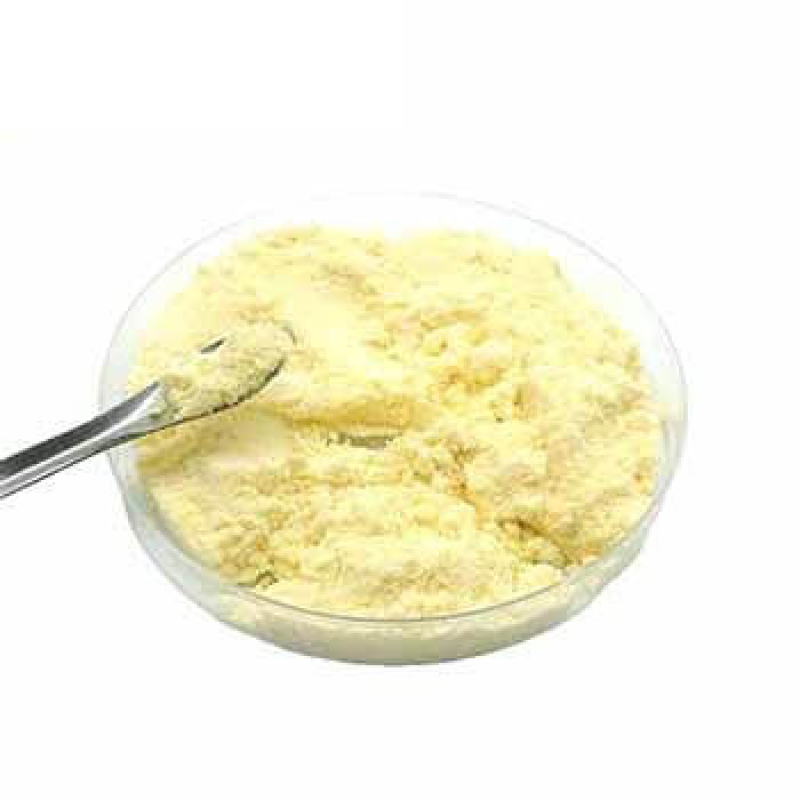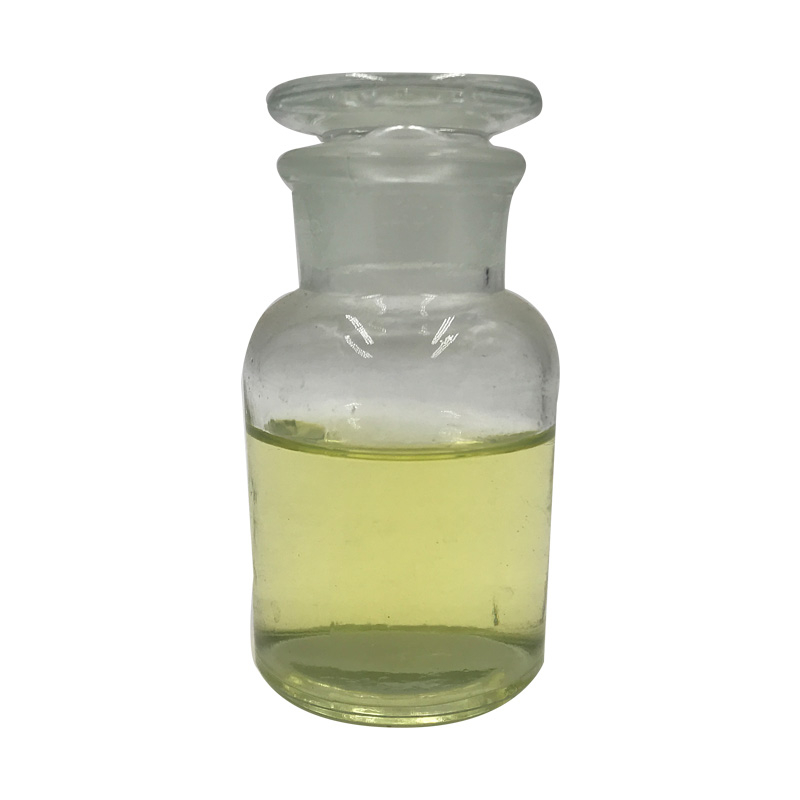Diethylenetriaminepenta(methylene-phosphonic acid) Chemical PropertiesBoiling point 1003.3±75.0 °C(Predicted)density 1.35 (50% aq.)vapor pressure 0Pa at 25℃storage temp. Hygroscopic, -20°C Freezer, Under inert atmospheresolubility Aqueous Base (Sparingly), Waterform Oilpka0.59±0.10(Predicted)color Pale Yellow to BrownWater Solubility 500g/L at 25℃BRN 2068968InChIKeyDUYCTCQXNHFCSJ-UHFFFAOYSA-NLogP-3.4CAS DataBase Reference15827-60-8(CAS DataBase Reference)EPA Substance Registry SystemPhosphonic acid, [[(phosphonomethyl)imino]bis[2,1-ethanediylnitrilo
Kontaktieren Sie mich jetzt
Products Description of Allylbenzene CAS#300-57-2Allylbenzene is an organic compound, a colorless liquid. Melting point -40℃, boiling point 156℃, flash point 33℃, relative density (20/4℃) 0.8920, refractive index 1.5131.
Kontaktieren Sie mich jetzt
Products Description of 7-Methylquinoline CAS#612-60-27-Methylquinoline can be used as a pharmaceutical and pesticide intermediate7-Methylquinoline Chemical PropertiesMelting point 35-37 °C(lit.)Boiling point 258 °C(lit.)density 1.061refractive index 1.6070 to 1.6210Fp >230 °Fstorage temp. Room Temperaturesolubility Chloroform (Slightly), Methanol (Slightly)pka5.44±0.14(Predicted)form Viscous Liquidcolor Off-White to Pale Beige Low-MeltingWater Solubility <0.1 g/100 mL at 20 ºCBRN 110317Stability:Stable.
Kontaktieren Sie mich jetzt
Sodium formate CAS#141-53-7The main purpose of sodium formate as follows:Sodium formate can be used as chemical analysis reagent, used for determination of arsenic and phosphorus, also used as a disinfectant, mordant and so on.
Kontaktieren Sie mich jetzt
Products Description of Imidazolidinyl urea CAS#39236-46-9White flowing powder, hygroscopic, odorless or with a slight characteristic odor, easily soluble in water, soluble in propylene glycol and glycerin, and hardly soluble in ethanol.Imidazolidinyl urea Chemical PropertiesMelting point 141-143℃Boiling point 514.04°C (rough estimate)density 1.4245 (rough estimate)vapor pressure 0Pa at 25℃refractive index 1.6910 (estimate)storage temp. 2-8°Csolubility Soluble in water and in glycerol, but insoluble in almost all organic solvents.pka7.41±0.10(Predicted)f
Kontaktieren Sie mich jetzt
Products Description of 5-CyanoindoleCAS#15861-24-2Off-white crystals, melting point 106-107℃.5-Cyanoindole Chemical PropertiesMelting point 106-108 °C(lit.)Boiling point 249.72°C (rough estimate)density 1.1777 (rough estimate)refractive index 1.6211 (estimate)storage temp. Keep in dark place,Inert atmosphere,Room temperaturesolubility Chloroform, Hexane, Methanolform Crystalline Powderpka15.62±0.30(Predicted)color White to slightly yellowWater Solubility Soluble in chloroform, hexane and methanol.
Kontaktieren Sie mich jetzt
Products Description of PolycaprolactoneCAS#24980-41-4Polycaprolactone (PCL) is a semi-crystalline polymer and a chemically synthesized biodegradable high molecular material. Its structural repeating unit contains 5 non-polar methylene groups - CH2.
Kontaktieren Sie mich jetzt
Products Description of VANPLAST 202 CAS#61790-48-5White powderVANPLAST 202 Chemical PropertiesBoiling point 1683.39℃[at 101 325 Pa]vapor pressure 0Pa at 25℃Water Solubility 1.714ng/L at 25℃LogP41.08 at 25℃EPA Substance Registry SystemSulfonic acids, petroleum, barium salts (61790-48-5)Factory and Equipment ShowFast delivery timeInventory 2-3 working days New production 7-10 working days
Kontaktieren Sie mich jetzt
Products Description of 2-Amino-5-chloropyrazine CAS#33332-29-52-Amino-5-chloropyrazine is a pyrazine compound, mainly used as an organic intermediate.CAS No.
Kontaktieren Sie mich jetzt
Products Description of 5-Bromo-8-nitroisoquinoline CAS#63927-23-1It is a light yellow solid powder at room temperature and pressure.
Kontaktieren Sie mich jetzt
Products Description of Pectin CAS#9000-69-5 Pectin (English: pectin) is a natural high molecular compound. It is mainly found in all higher plants and is an important component of plant cell matrix. Pectin is deposited in the primary cell wall and intercellular layer. In the primary wall, it cross-links with microfibrils of cellulose, hemicellulose, lignin and certain extensins of different contents, making various cell tissue structures hard and showing inherent morphology, and serving as a supporting substance for internal cells.
Kontaktieren Sie mich jetzt
Products Description of ISOQUINOLINE-3-CARBOXYLIC ACID CAS#203626-75-9 Isoquinoline-3-carboxylic acid, monohydrate is an organic compound.Isoquinoline-3-carboxylic acid Chemical PropertiesMelting point 166-168 °C(lit.)storage temp. 2-8°Cform powder to crystalcolor White to Light yellow to Light orangeSafety InformationHazard Codes XiRisk Statements 36/37/38Safety Statements 26-37/39WGK Germany 3Product Application of Isoquinoline-3-carboxylic acidIsoquinoline-3-carboxylic acid, monohydrate is often used as an intermediate.Factory
Kontaktieren Sie mich jetzt
Products Description of (R)-(-)-3-Carbamoymethyl-5-methylhexanoic acid CAS#181289-33-8(R)-(-)-3-(Carbamoylmethyl)-5-methylhexanoic acid is solid at room temperature and pressure, soluble in dimethyl sulfoxide, N,N-dimethylformamide and other organic solvents; it has poor solubility in ether solvents and can be used as an intermediate in chiral organic synthesis.
Kontaktieren Sie mich jetzt
Products Description of Thiosalicylic acid CAS#147-93-3Thiosalicylic acid, o-mercaptobenzoic acid, white triclinic crystals or white solids. Soluble in ethanol and glacial acetic acid, slightly soluble in water. Used in the preparation of thioindigo dyes, and also used as a reagent for iron analysis.
Kontaktieren Sie mich jetzt
Products Description of Direct Red 23 CAS#3441-14-3 Purple-red powder. Moderately water-soluble, bright red when dissolved in water, its aqueous solution turns light blue when adding dilute sulfuric acid, produces wine-red precipitate when adding concentrated hydrochloric acid, and turns reddish orange-brown when adding concentrated alkali. Slightly soluble in ethanol and orange, insoluble in acetone.
Kontaktieren Sie mich jetzt
Products Description of Gadoteric acid CAS#72573-82-1White powderGadoteric acid Chemical PropertiesMelting point >300°Cstorage temp. Refrigeratorsolubility Water (Slightly)form Solidcolor White to Off-White Factory and Equipment ShowFast delivery timeInventory 2-3 working days New production 7-10 working days
Kontaktieren Sie mich jetzt
Products Description of Dehydroacetic acid CAS#520-45-6DHA is widely found in many deep-sea fish oils, as well as in marine algae and some terrestrial plants. DHA is an ω-3 type unsaturated fatty acid and an essential fatty acid for the body. mp44℃. It is very unstable to light, oxygen and heat, and is easily oxidized and cracked, so antioxidants should usually be added.
Kontaktieren Sie mich jetzt
Products Description of Myrcene CAS#123-35-3 Myrcene is a colorless to light yellow oily liquid. It has a sweet orange flavor and balsamic odor; boiling point 167°C; flash point 37.2°C; soluble in ethanol, ether, chloroform, glacial acetic acid and most non-volatile oils, insoluble in water.
Kontaktieren Sie mich jetzt
Products Description of TetrachloroethyleneCAS#127-18-4Tetrachloroethylene, also known as perchloroethylene, is a compound formed by replacing all hydrogen atoms in ethylene with chlorine in terms of molecular structure. It was first produced by Faraday in 1821 when he pyrolyzed hexachloroethane. It is a colorless, transparent liquid with an ether-like odor. It is non-flammable. Its relative molecular mass is 165.85. Its relative density is 1.6220. Its melting point is -22.7℃. Its boiling point is 121.2℃ and 33.2℃ (4.000×103Pa). Its refractive index is 1.5055.
Kontaktieren Sie mich jetzt
Industrial-grade acetic acid CAS#64-19-7Chemical Properties:Our Industrial-Grade Acetic Acid, a carboxylic acid with the molecular formula C2H4O2, boasts a melting point of 16.63°C and a boiling point of 117.9°C, making it a liquid at room temperature with a refractive index of 1.3716 and a density of 1.048. It is miscible with water and ethanol, forming a hydrophilic and polar protic solvent that dissolves in water and is widely used in industrial processes.Reactivity and Corrosion:Acetic acid is known to corrode certain metals such as magnesium, zinc, and iron, forming acetate salts.
Kontaktieren Sie mich jetzt
Methyl Acetate CAS#79-20-9Methyl acetate, additionally viewed as MeOAc , acetic acid methyl ester or methyl ethanoate, is a carboxylate ester with the formula CH3COOCH3. It is a flammable liquid with a generally high-quality smell reminiscent of some glues and nail polish removers.
Kontaktieren Sie mich jetzt
Products Description of Antimony triacetate CAS#6923-52-0Antimony(III) acetate is an antimony compound with the chemical formula Sb(CH3CO2)3.
Kontaktieren Sie mich jetzt
Products Description of 3-Hydroxy-1-AdaMantane Carboxylic Acid CAS#42711-75-13-Hydroxyadamantane can be used to synthesize potent pyridineamide/sulfonamide inhibitors of 11β-HSD-1, which can be used to treat ulcers or hormone therapy related to cortisol3-Hydroxy-1-AdaMantane Carboxylic Acid Chemical PropertiesMelting point 203 °CBoiling point 357.2±25.0 °C(Predicted)density 1.419±0.06 g/cm3(Predicted)storage temp. Sealed in dry,Room Temperaturesolubility DMSO (Slightly), Methanol (Slightly)form Solidpka4.60±0.40(Predicted)color Off-WhiteInChIInChI=1S/C11
Kontaktieren Sie mich jetzt
Products Description of Poly(dipropyleneglycol)phenyl phosphite CAS#80584-86-7Colorless liquidFactory and Equipment ShowFast delivery timeInventory 2-3 working days New production 7-10 working days
Kontaktieren Sie mich jetzt


































